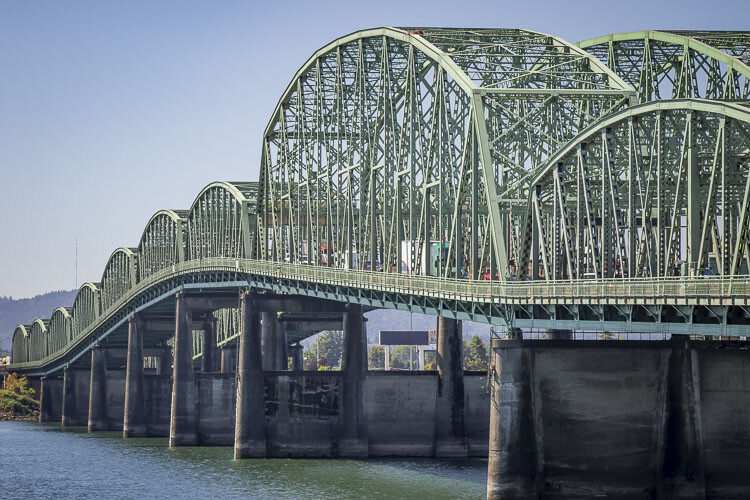
Editor Ken Vance shares changes to elements of the proposed project that he believes many Southwest Washington residents would support
Ken Vance, editor
Clark County Today
For many Clark County citizens, support of a replacement project for the I-5 Bridge comes down to two elements in the Interstate Bridge Replacement Program’s (IBR) Locally Preferred Alternative (LPA) that I object to. Those are the choice of light rail as the transit element of the project and the use of tolls to help pay for it.

There are many, many other elements of the proposed project that still face scrutiny by members of the public, community leaders and elected officials but for the sake of this discussion, I’m going to focus on light rail and tolling.
I believe it is important to point out that when a public vote was held about extending TriMet MAX light rail across the Columbia River into Clark County in 2012, a majority of voters in every city in Clark County, including Vancouver, rejected the C-TRAN ballot proposition. Again in 2013, voters supported a vote on light rail prior to any funds being spent on it, even though a county-wide vote was never held. I wish I could share more recent proof, but it is my belief that a majority of Clark County residents still oppose light rail.
When it comes to tolling, I don’t think it’s much of a leap for most of us to think that a majority of drivers would prefer to continue to not pay tolls to drive on roads or cross bridges that currently are not tolled. One anecdotal note to support that theory is that in 2017-2018, the Oregon Department of Transportation (ODOT) put together a Value Pricing Policy Advisory Committee. During that process, ODOT officials informed the members of the committee that 50,000 drivers were currently leaving the highways and traveling on side roads due to a lack of vehicle capacity. If tolling were to be implemented on Portland’s highways, ODOT officials estimated an additional 80,000 drivers would divert to the side streets to avoid paying tolls. Add to that the fact that in May, Oregon Gov. Tina Kotek and the Oregon Legislature recognized that ODOT needed to slow down on its tolling plans, in large part to resistance from the public. As a result, tolls will not be collected until 2026 and a new legislative subcommittee on Transportation Planning has been formed
When the IBR team announced details of its LPA in April 2022, it was revealed that the transit component of the project would be an extension of TriMet’s MAX light rail line across the new bridge and into downtown Vancouver. Since that announcement, the IBR team has provided cost estimates that indicate the light rail element of the project will cost as much as $1.99 billion. Total price of the project is expected to be between $6 billion and $7.5 billion. The IBR team reports that it hopes to get between $900 million and $1.2 billion from the Federal Transit Administration (FTA), which would leave the project with a funding shortfall of as much as $1.1 billion for the light rail component. Ironically, that is eerily close to the $1.25 billion the IBR team hopes to raise by tolling travelers, including the 75,000 or so Southwest Washington residents who commute to Oregon for work.
Let’s eliminate both elements with one decision
I have never said that I oppose a project that would replace the I-5 Bridge. I do, however, oppose any project that includes tolls and an extension of TriMet;s MAX light rail into Vancouver. It is my preference that we focus on creating a third crossing and corridor over the Columbia River first and then move on to the replacement of the I-5 Bridge after that. But, many disagree with me, believing there is greater urgency in replacing the I-5 Bridge so that a significant seismic event doesn’t cause it to crumble into the water below.
So, for the sake of this discussion, let’s continue to focus on the current project. I believe it would please a majority of Southwest Washington residents if the light rail component of the current project was replaced with Bus Rapid Transit (BRT). C-TRAN is currently working on its third BRT project in Clark County. The cost of each of those projects has been roughly $50 million, far less than the (as high as) $1.99 billion price tag of the proposed light rail element of the current I-5 Bridge replacement project.
I confess I’m not a transit expert. But, transit ridership across the Columbia River continues to hover below pre-pandemic numbers. An estimated 1,000 citizens currently use transit to cross the border each day. I understand, as a community, it is important that we serve those citizens and their dependency on transit. But, wouldn’t it be more efficient to do so with millions of dollars rather than billions?
Obviously, C-TRAN officials have devoted a great deal of time, effort and energy into their BRT projects. C-TRAN CEO Shawn Donaghy supports the light rail element currently proposed in the I-5 Bridge replacement project. However, Donaghy recently told area legislators that federal transit officials are big supporters of BRT projects and he elaborated on those comments in an email exchange with Clark County Today.
“During a recent discussion with some SW Washington legislators, the subject of C-TRAN’s Mill Plain BRT project came up and I shared with the group that the FTA was/is a big supporter of this project,’’ Donaghy wrote in his email response to me. “FTA is funding many BRT projects across the nation in part because they typically cost less and provide more flexibility compared to other modes. In fact, at C-TRAN’s groundbreaking event for Mill Plain BRT, it was noted by FTA and others that BRT has created a great opportunity for Clark County and they see this as a key part of our continued growth into the future.
“While the FTA certainly supports all modes of transit, there continues to be strong funding support for BRT projects across the country in areas where there may not be population densities and land use that supports other high capacity transit modes like light rail,’’ Donaghy wrote. “This is not the case as it relates to the IBR project, given the existing light rail network in Portland that will be extended just across the Columbia River to Evergreen.
“C-TRAN’s long-range plan is based on a BRT system throughout the Clark County, but as we have communicated related to the IBR project and C-TRAN’s approval of the MLPA last year, extending LRT to Evergreen is the best location for our transit systems to connect while providing another high capacity option for our residents to use who need to travel into Portland,’’ Donaghy added.
I respect Donaghy. He’s a transit guy and I’m not. Reasonable people can respectfully agree to disagree. We’re not going to see eye-to-eye on every transit project. So, it’s his belief that light rail is the best project for the I-5 Bridge replacement. I, however, do not share that belief and I think there is ample evidence to suggest a majority of citizens agree with me.
As a result, I call on our elected officials and community leaders to join a great number of Southwest Washington residents in calling for C-TRAN’s Bus Rapid Transit to replace TriMet’s MAX light rail on the I-5 Bridge replacement project. It would trim the overall cost of the project by as much as $2 billion while also eliminating the need for tolls on the new bridge.
Also read:
- POLL: Is America more united or more divided than it was a decade ago?Clark County Today’s weekly poll asks: Is America more united or more divided today? The question comes after Stephen Davis brought a powerful message to Vancouver.
- Opinion: Revolution or revival?Nancy Churchill argues that Washington state is ground zero for a Marxist-style revolution but says a cultural revival is possible through personal responsibility and the America First movement.
- Letter: ‘It’s said sarcasm is the lowest form of wit’Amboy resident Thomas Schenk criticizes Olympia’s use of “emergency clauses” and other legislative tactics that limit public participation.
- Letter: ‘We’re going to give them some money and a plane ticket, and then we’re going to work with them’Camas resident Anna Miller supports a new structured self-deportation policy, calling it a balanced approach to immigration and economic needs.
- Opinion: What the 2025 legislature tells us about why Washington’s government keeps failingTodd Myers of the Washington Policy Center argues that Washington’s government fails because it resists humility, experimentation, and accountability in its policymaking.
Also read:
- IBR only has single firm interested in managing the project to replace I-5 BridgeRep. John Ley reports on serious concerns with the I-5 Bridge replacement project, including limited contractor interest, rising tolls, and a 15-year timeline.
- Busy pavement season ahead on Vancouver streetsThe city of Vancouver is set to repave and preserve 76 lane miles across 20 neighborhoods in summer 2025, with ADA upgrades and community notices throughout.
- State representative: Expect sticker shock when Interstate Bridge project officials reveal price, tolling plansAt a town hall in Battle Ground, Rep. John Ley warned of major cost increases and tolling burdens tied to the Interstate Bridge replacement project.
- Opinion: Washington state lawmakers increase the cost of driving – againBob Pishue of Mountain States Policy Center argues that new vehicle and fuel taxes in Washington will raise driving costs while diverting funds away from roads.
- Overnight full closure of I-5 near Woodland for bridge inspection, May 6WSDOT will fully close southbound I-5 near Woodland overnight on Tuesday, May 6 for a bridge inspection using a chain drag test.















